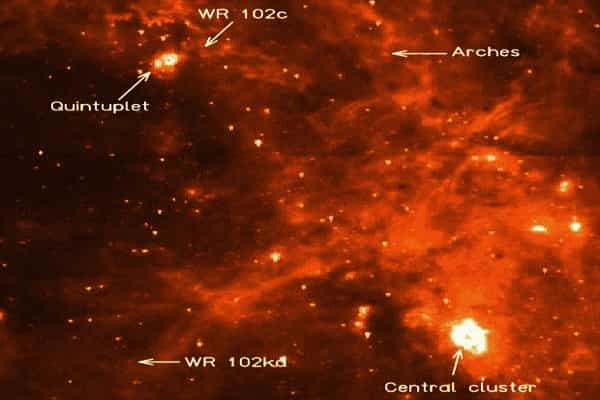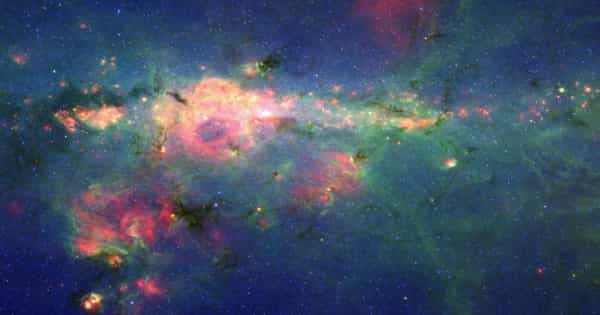The star WR 102ka is a blue supergiant. It’s a Wolf-Rayet star, an extremely hot star on the verge of dying. It can be found in the constellation Sagittarius, near the center of the Milky Way. It has completed the primary sequence of its life. The Main Sequence is the period of a star’s life when it has completed the process of burning/converting hydrogen into helium. It is 92 times larger and 3.2 million times brighter than the Sun.
WR 102ka, also known as the Peony star, is a Wolf–Rayet star that is one of several candidates for the Milky Way’s most luminous star. The temperature is approximately 210,000 Kelvin. It is one of three stars with a temperature of 200,000 degrees Celsius or higher. The other two are WR 142 in Cygnus and LMC 195-1 in the satellite galaxy The Large Magellanic Cloud. They are all Wolf-Rayet stars.
Properties
This Wolf-Rayet star is located in the Peony nebula, close to our galaxy’s center. It is one of the brightest stars in the Milky Way galaxy and a likely candidate for a supernova. It had at least 150 solar masses at the start, of which it has most likely lost a significant portion. WR 102ka is obscured by thick layers of dust and thus difficult to observe.
- Constellation: Sagittarius
- Distance: 26 000 light-years
- Spectral class: WN10
- Luminosity: 3.2 million * Sun
- Diameter: 100 * Sun

Discovery
WR 102ka is located near the Galactic Center and is completely obscured in visible wavelengths. As a result, it must be observed in longer-wavelength infrared light that can penetrate the dust. Infrared surveys were used to catalog WR 102ka in 2002 and 2003. It was observed for the Two-Micron All-Sky Survey (2MASS) at 1.2 m, 1.58 μm, and 2.2 μm in the near-infrared J, H, and Ks bands, respectively, and for the ISOGAL survey of candidate young stellar objects at 7 μm and 15 μm.
Observations of several spectral features around 2 m in narrowband infrared revealed that WR 102ka was a Wolf Rayet star with a likely classification of WN10. It was also suggested as a luminous blue variable.
On April 20, 2005, the Spitzer Space Telescope observed WR 102ka at wavelengths of 3.6 μm, 8 μm, and 24 μm. These observations enabled the first reliable calculations of this extremely luminous object’s physical properties.
Other luminous Milky Way stars
WR 25, an even brighter but closer star, appears to be the most likely winner. Eta Carinae, a nearby star that was the second-brightest star in the sky for a few years in the 19th century, appears to be slightly brighter than WR 102ka, but it is known to be a binary star system. There is also the more recently discovered Pistol Star, which, like the Peony star, derives its name from the shape of the nebula in which it is embedded, and which it has most likely created through heavy mass loss via fierce stellar winds and possibly also major “mini-supernova-like” eruptions, as Eta Carinae did around the 1830s–1840s, resulting in the lobes observed by the Hubble Space Telescope.
















